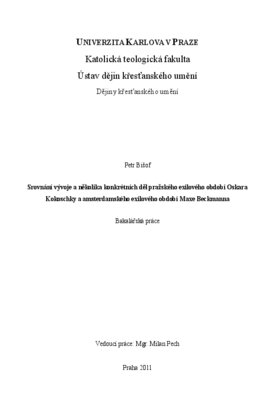Srovnání vývoje a několika konkrétních děl pražského exilového období Oskara Kokoschky a amsterdamského exilového období Maxe Beckmanna
Comparison of progress and several specific masterpieces of Oscar Kokoschka`s Prague exile period and Max Beckmann`s Amsterdam exile period
bachelor thesis (DEFENDED)

View/
Permanent link
http://hdl.handle.net/20.500.11956/50877Identifiers
Study Information System: 83436
CU Caralogue: 990014326990106986
Collections
- Kvalifikační práce [2276]
Author
Advisor
Referee
Bendová, Eva
Faculty / Institute
Catholic Theological Faculty
Discipline
History of Christian Arts
Department
Institute of Christian Art History
Date of defense
30. 1. 2012
Publisher
Univerzita Karlova, Katolická teologická fakultaLanguage
Czech
Grade
Excellent
Práce se zabývá pražským exilovým obdobím Oskara Kokoschky a amsterodamským exilovým obdobím Maxe Beckmanna. Právě tito dva malíři byli vybráni proto, že oba byli představiteli expresionistického stylu, oba byli generačními vrstevníky (Beckmann nar. 1884, Kokoschka nar. 1886) a na oba proto působily podobné společensko-politické vlivy (z hlediska práce je v tomto směru nejdůležitější politický útlak 30. let). Stěžejní část práce se tedy zabývá otázkou, jak proměnil život v exilu, stejně jako represe a zastrašování ze strany nacistického režimu, umělecký vývoj obou autorů. Tyto změny se autor snaží postihnout ve třech částech tvorby - v autoportrétech, krajinomalbách a v obrazech se symbolickými prvky. V rámci těchto oblastí porovnává, jak odlišně výtvarně oba malíři reagovali na podobné mimoumělecké vlivy (například zpolitizovaná výstava "Entartete Kunst") a jakým způsobem vnímali sami sebe v tomto dramatickém období.
The work deals with Prague exile period of Oscar Kokoschka and Amsterdam exile period of Max Beckmann. Right these two artists were choosen for the reason, that both were representatives of expressionistic style, they belonged to same generation (Beckmann born in 1884, Kokoschka 1886) and both were affected by the similar social-political influences (from the work point of view is the most important influence the political oppression of the third decade). The main part of this work deals with a question, how the life in exile, as well as repression and intimidation from the nazi regime, changed artisctic progress of both artists, whereas the author tries to describe these changes in three features of art - in self-portrait, landscape-painting and allegoric paintings. In the scope of these areas he tries to compare how did these two artists react to the same influences outside art (for example politicized exhibition "Entartete Kunst"), how did they see themselves in this dramatic era, and to show this at specific pieces of art.
